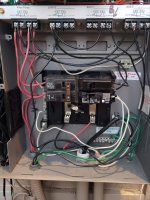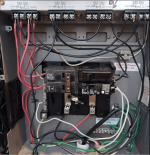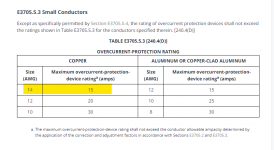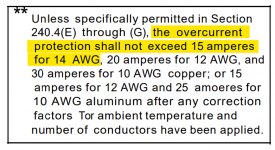Wiring help - No neutral wires on breakers
- Thread starter OolDad
- Start date
You are using an out of date browser. It may not display this or other websites correctly.
You should upgrade or use an alternative browser.
You should upgrade or use an alternative browser.
Since you have open breaker slots I would add a 120V 20A GFCI CB and move the lights to that breaker. Move the green dot hot wire on my pic above that powers the controller to go directly into the existing 120V CB.
That keeps your controller on a separate CB from your lights. Should your lights trip the GFCI your controller will not go down. Otherwise having a GFCI problem with your lights can shutdown the controller and your entire pool.
Your actual loads is around 18 amps between your pump, blower, lights and controller. Adding another breaker and separating the lights and controller to separate breakers adds no additional loads to the panel.
Leave the controller on the existing 120V breaker and add a 120V GFCI CB for the lights.
Thanks for all this. I put in the breaker this way, but wondering now if it would be better to keep the controller protected on the GFCI. If you look at the picture of the entire unit, you can see the LCD took a beating from the lightning. Does it really matter if the controller goes down with the lights? I guess only if it's down for an extended period? If there is an issue, either I can reset the GFCI or I'm replacing breakers and maybe equipment. Could always put the controller back on the regular breaker if there is an extended problem. Am I missing something?
Here's the installed GFCI:
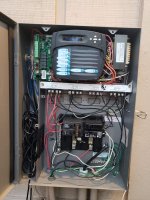
Changing the pump CB to a GFCI is easy. I don't understand your reluctance to increase the safety. I don't understand what neutrals you are musing about. A 240V pump does not have any neutrals. Your pump is on and electrified much more then your lights are.
I see the lights as more of a concern because there are wires in the water with my kids. The pump is 30' away, and wasn't considered an issue until relatively recently as far as code.
Mostly concerned about neutrals because the 2-pole QP GFCI has a neutral out and nothing will be going in. Looking at the Siemens QF220 as an example. What do I do with the neutral from the GFCI CB? Is that the wrong CB for 240v with no neutrals?
Attachments
guinness
Well-known member
Having a GFCI breaker won't protect your controller from electrical surges.I put in the breaker this way, but wondering now if it would be better to keep the controller protected on the GFCI. If you look at the picture of the entire unit, you can see the LCD took a beating from the lightning.
Electrical Surge Protection - Further Reading
The neutral out goes to the neutral bar.Mostly concerned about neutrals because the 2-pole QP GFCI has a neutral out and nothing will be going in.
It does not matter if there is no neutral in.
- Jul 21, 2013
- 65,253
- Pool Size
- 35000
- Surface
- Plaster
- Chlorine
- Salt Water Generator
- SWG Type
- Pentair Intellichlor IC-60
Thanks for all this. I put in the breaker this way, but wondering now if it would be better to keep the controller protected on the GFCI. If you look at the picture of the entire unit, you can see the LCD took a beating from the lightning.
GFCI provides no protection from lightning or surges.
Electrical Surge Protection - Further Reading
Does it really matter if the controller goes down with the lights? I guess only if it's down for an extended period? If there is an issue, either I can reset the GFCI or I'm replacing breakers and maybe equipment.
GFCI CB may not reset with a light ground fault problem. And fixing a light ground fault may take a while to diagnose and fix.
Could always put the controller back on the regular breaker if there is an extended problem. Am I missing something?
You will not have a regular breaker to put the controller onto unless you leave your old one in. In which case just connect the controller power to it now which looks like you did..
Mostly concerned about neutrals because the 2-pole QP GFCI has a neutral out and nothing will be going in. Looking at the Siemens QF220 as an example. What do I do with the neutral from the GFCI CB?
Neutral from the 240V GFCI CB connects to the neutral bus.
Is that the wrong CB for 240v with no neutrals?
There is no neutral wires connected in a 240V circuit. It is the correct CB.
You only have a neutral connected to the CB if you use one side of the 240V CB to power a 120V load.
On a 2-pole 240v GFCB, the neutral wire from the breaker is hooked to the neutral bus. If you don't do that it won't "test." No neutral to the motor. A 2-pole GFCB measures the current on each leg and if they get out of balance by 5mA it will trip to protect you, not the equipment.Thanks for all this. I put in the breaker this way, but wondering now if it would be better to keep the controller protected on the GFCI. If you look at the picture of the entire unit, you can see the LCD took a beating from the lightning. Does it really matter if the controller goes down with the lights? I guess only if it's down for an extended period? If there is an issue, either I can reset the GFCI or I'm replacing breakers and maybe equipment. Could always put the controller back on the regular breaker if there is an extended problem. Am I missing something?
Here's the installed GFCI:
View attachment 460850
I see the lights as more of a concern because there are wires in the water with my kids. The pump is 30' away, and wasn't considered an issue until relatively recently as far as code.
Mostly concerned about neutrals because the 2-pole QP GFCI has a neutral out and nothing will be going in. Looking at the Siemens QF220 as an example. What do I do with the neutral from the GFCI CB? Is that the wrong CB for 240v with no neutrals?
A GFCI device protects people, not equipment. Having one, or not having one, on the pool control is up to you.
If your lights are sharing a neutral and ground, you need to make sure that they are sized correctly.
What is the power rating for your lights?
What is the wire size for the neutral and ground?
What is the power rating for your lights?
What is the wire size for the neutral and ground?
I'm pretty skeptical of surge protectors these days. I have some good ones, and they made no difference as to what got fried. All my GFIs were tripped in the house, and anything that was attached to them was fine.Having a GFCI breaker won't protect your controller from electrical surges.
Electrical Surge Protection - Further Reading
www.troublefreepool.com
We did get a surge protector put on our meter by the electric company that comes with insurance for next time.
GFCI CB may not reset with a light ground fault problem. And fixing a light ground fault may take a while to diagnose and fix.
You will not have a regular breaker to put the controller onto unless you leave your old one in. In which case just connect the controller power to it now which looks like you did..
Neutral from the 240V GFCI CB connects to the neutral bus. There is no neutral wires connected in a 240V circuit. It is the correct CB.
You only have a neutral connected to the CB if you use one side of the 240V CB to power a 120V load.
Got it re the controller, just wanted to double check before I broke off the blank on the panel. I was thinking I might keep it all on the GFCI and put aside the regular breaker for temporary use while diagnosing any issue with the lights. If there's no benefit to doing that, I'll break off the blank and leave it as is.
Appreciate the clarifications from everyone on the 240v CB wiring. Guess it's too simple not to do. I wasn't really trying to get into the panel, just wanted to change the pool light. Like every other repair, it's spiraling into $100s of unplanned fixes along the way. Overall the lightning did more than $6000 in damage, so I've been trying to keep repair costs down.
They are 120v with 12AWG wiring I believe. Both are currently Hayward, but I have to change the pool light because ColorLogic isn't serviceable. I've heard there's a way to change the light engine with a Pentair part, but I'm not looking to mess with that. So, I'll probably replace it with a Hayward Astrolite, if that's the best option, and add an LED bulb. In that case, I expect the wiring will be the same size but I won't know until I get it.If your lights are sharing a neutral and ground, you need to make sure that they are sized correctly.
What is the power rating for your lights?
What is the wire size for the neutral and ground?
On a 2-pole 240v GFCB, the neutral wire from the breaker is hooked to the neutral bus. If you don't do that it won't "test." No neutral to the motor. A 2-pole GFCB measures the current on each leg and if they get out of balance by 5mA it will trip to protect you, not the equipment.
A GFCI device protects people, not equipment. Having one, or not having one, on the pool control is up to you.
I was thinking along the lines of using a GFCI as GFPE since it's already in the box. It wouldn't matter to me if it trips at the lower current.
Very low watt LED bulbs. I think the Spa bulb is 35 watts. Not sure exactly what bulb I will get for the pool, but I expect it will be 35-50watts in a fixture made for a 400w - 500w bulb.Do you know the watts or amps for the lights?
Based on the 2 lights not drawing much power?I would have used a 15 amp breaker.
In my opinion, a 20 amp breaker is oversized for the application.
Assuming the light wires are #14 AWG copper, the maximum allowable breaker is 15 amps.
The wires in this box are #12 AWG copper. Not sure what the new light wire will be or what's in the junction box. Still go with 15A if it's all #12 AWG copper?
There's a remanent of something on top of the jacket, the wire is fine. Can't tell exactly what it was, probably labeling the wire. I'll cut it off or cut the wire back behind that so an inspector doesn't draw the same conclusion in the future.This wire is damaged and it should be replaced (Red Arrow).
I would replace both single pole breakers with 15 amp GFCI breakers and the double pole breaker with a 20 amp GFCI breaker (assuming the pump wires are #12 AWG copper).
The 2-pole GFCI should be here tomorrow for the pump. I also ordered a replacement 20A regular CB for the controller, but maybe that should have been 15A. Or even 10A? If that should be on a GFCI for GFPE, I would probably just leave it all on the same GFCI. If both lights and controller are on the same GFCI, better 20A or 15A?
The light wires look like #14 AWG.
There should be some writing on the wires that says what size they are.
There should be some writing on the wires that says what size they are.
Size 18 and 16 AWG copper conductors were added to the 2008 edition of the NEC.
The overcurrent device shall not exceed 7A for an 18 AWG copper conductor and 10A for a 16 AWG copper conductor.
Besides the provisions for the overcurrent device’s maximum ampacity, 18 and 16 AWG conductors have additional stipulations.
The first stipulation for 18 AWG conductors states that continuous loads shall not exceed 5.6A.
Likewise, the first stipulation for 16 AWG conductors states that continuous loads shall not exceed 8A.
The overcurrent device shall not exceed 7A for an 18 AWG copper conductor and 10A for a 16 AWG copper conductor.
Besides the provisions for the overcurrent device’s maximum ampacity, 18 and 16 AWG conductors have additional stipulations.
The first stipulation for 18 AWG conductors states that continuous loads shall not exceed 5.6A.
Likewise, the first stipulation for 16 AWG conductors states that continuous loads shall not exceed 8A.
Thread Status
Hello , This thread has been inactive for over 60 days. New postings here are unlikely to be seen or responded to by other members. For better visibility, consider Starting A New Thread.


